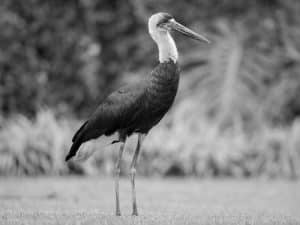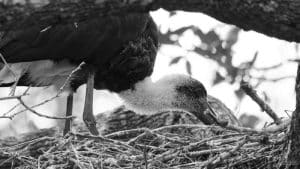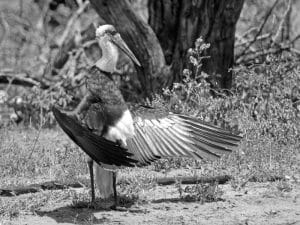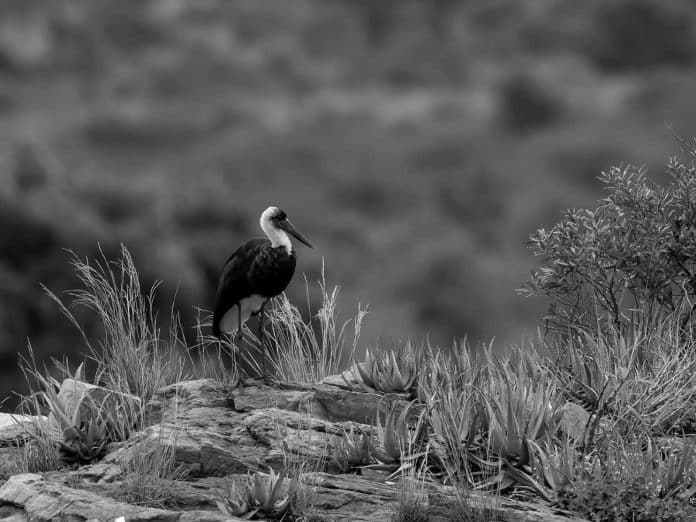Introduction to the African Woolly-Necked Stork
The African Woolly-Necked Stork, scientifically known as Ciconia episcopus, is a magnificent bird species that can be found in the wetlands of Tanzania. With its striking appearance and graceful movements, this stork is a true symbol of nature’s beauty. In this article, we will explore the habitat, physical characteristics, behavior, breeding patterns, conservation status, and the important role that the African Woolly-Necked Stork in Tanzania plays in wetland ecosystem. Whether you are an avid bird watcher or simply intrigued by the wonders of nature, this article will provide you with valuable insights into this captivating species.
Habitat and Distribution of the African Woolly-Necked Stork in Tanzania

The African Woolly-Necked Stork is primarily found in the wetlands of Tanzania, where it thrives in the diverse ecosystems of the region. These wetlands include lakes, rivers, swamps, and marshes, providing the stork with an abundant source of food and suitable nesting grounds. Tanzania’s wetlands offer a perfect mix of vegetation and water, creating an ideal environment for these birds to flourish.
The distribution of the African Woolly-Necked Stork in Tanzania is widespread, with sightings reported in various regions across the country. Some of the prominent locations where these storks can be observed include the Serengeti National Park, Lake Manyara National Park, and the Selous Game Reserve. These protected areas not only provide a safe haven for the storks but also allow tourists and researchers to witness their majestic presence.
Physical Characteristics of the African Woolly-Necked Stork
The African Woolly-Necked Stork is a large bird, measuring approximately 90-105 centimeters in height and having a wingspan of 150-165 centimeters. The most distinctive feature of this stork is its long, woolly neck, which is covered with white feathers. The neck is adorned with black stripes, adding to the stork’s elegant appearance.
The plumage of the African Woolly-Necked Stork is predominantly white, with black feathers on its wings and upper body. The beak is long and pointed, allowing the stork to catch its prey with precision. The legs of the stork are long and slender, enabling it to wade effortlessly through the shallow waters of the wetlands. Overall, the African Woolly-Necked Stork is a truly captivating bird, with its striking physical features leaving a lasting impression on anyone fortunate enough to observe it.
Behavior and Feeding Habits of the African Woolly-Necked Stork
The African Woolly-Necked Stork is known for its graceful and patient hunting techniques. It primarily feeds on a diet consisting of fish, frogs, small reptiles, and insects. With its keen eyesight, the stork patiently waits in the water, motionless, until it spots its prey. Once the opportunity arises, it swiftly strikes with its sharp beak, capturing its meal.
These storks are often seen foraging in groups, making their way through the shallow waters of the wetlands. They use their long legs to stir up the muddy bottom, disturbing small aquatic creatures and making them easier to catch. The African Woolly-Necked Stork’s feeding habits play a crucial role in the wetland ecosystem, as they help maintain the balance of the aquatic populations and contribute to the overall health of the ecosystem.
Breeding and Nesting Patterns of the African Woolly-Necked Stork

Breeding season for the African Woolly-Necked Stork occurs during the rainy season, which typically falls between November and March in Tanzania. During this time, these storks engage in elaborate courtship rituals, which involve displays of their wings, necks, and vocalizations. These displays are not only a way to attract a mate but also serve as a means of establishing and defending their territory.
Once a pair is formed, the storks build their nests in tall trees near water bodies. The nests are large and sturdy, constructed with sticks and lined with soft materials such as grass and leaves. The female stork usually lays 2-5 eggs, which are incubated by both parents for about a month. After hatching, the chicks are cared for and fed by their parents until they are ready to fledge. The breeding and nesting patterns of the African Woolly-Necked Stork highlight its dedication to the survival and growth of its species.
Conservation Status and Threats to the African Woolly-Necked Stork
The African Woolly-Necked Stork is currently listed as a species of least concern on the International Union for Conservation of Nature (IUCN) Red List. However, like many other bird species, it faces various threats to its population. Habitat loss due to human activities, such as the conversion of wetlands into agricultural land, poses a significant challenge for the storks. Pollution of water bodies and the use of pesticides also affect their food sources and can have detrimental effects on their health.
Another threat to the African Woolly-Necked Stork is the illegal trade of their feathers and eggs. Despite legal protection, the demand for these items continues to persist, posing a threat to the population of these magnificent birds. Efforts are being made by local and international organizations to combat these threats and ensure the long-term survival of the African Woolly-Necked Stork in Tanzania.
The Role of the African Woolly-Necked Stork in Tanzania’s Wetland Ecosystem
The African Woolly-Necked Stork plays a vital role in Tanzania’s wetland ecosystem. Their feeding habits help control the populations of fish and amphibians, preventing overpopulation and maintaining the ecological balance. Additionally, their nesting activity contributes to the recycling of nutrients, as the remains of their prey are returned to the ecosystem.
These storks also act as indicators of wetland health. Their presence and abundance can provide valuable insights into the overall condition of the wetlands and help identify any changes or disturbances in the ecosystem. By monitoring the African Woolly-Necked Stork populations, conservationists can assess the effectiveness of conservation efforts and take necessary actions to protect these valuable habitats.
Tips for Spotting and Photographing the African Woolly-Necked Stork in Tanzania

Spotting and photographing the African Woolly-Necked Stork can be a rewarding and memorable experience. To increase your chances of a successful encounter, it is recommended to visit the wetlands of Tanzania during the early morning or late afternoon when the storks are most active. Look for areas with abundant water and vegetation, as these are likely to attract these magnificent birds.
When photographing the African Woolly-Necked Stork, it is essential to maintain a respectful distance and avoid disturbing their natural behavior. Using a telephoto lens can help capture their intricate details without intruding on their space. Patience is key, as these storks may spend long periods motionless or engaged in hunting activities. With careful observation and a bit of luck, you can capture stunning images of these graceful waders.
Organizations and Initiatives Working towards the Conservation of the African Woolly-Necked Stork
Several organizations and initiatives are dedicated to the conservation of the African Woolly-Necked Stork and its habitat in Tanzania. These include both local and international organizations, such as the Tanzania Bird Atlas Project, the Wildlife Conservation Society, and the African Bird Club. These organizations work towards raising awareness, conducting research, and implementing conservation strategies to protect the stork and its wetland habitats.
By supporting these organizations through donations or volunteering, you can contribute to the conservation efforts and help secure a brighter future for the African Woolly-Necked Stork in Tanzania. Together, we can ensure that these graceful waders continue to thrive in their natural habitats for generations to come.
Conclusion
The African Woolly-Necked Stork is a true testament to the wonders of nature. Its graceful presence and significant role in Tanzania’s wetland ecosystem make it an invaluable species deserving of our admiration and protection. By understanding its habitat, physical characteristics, behavior, and breeding patterns, we can appreciate the importance of conserving this magnificent bird. Whether you are a nature enthusiast, a bird watcher, or simply intrigued by the wonders of the natural world, the African Woolly-Necked Stork is a species that will captivate your heart and inspire a deeper appreciation for the beauty of Tanzania’s wetlands.


































